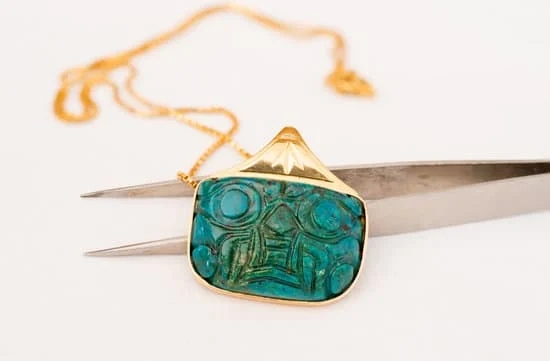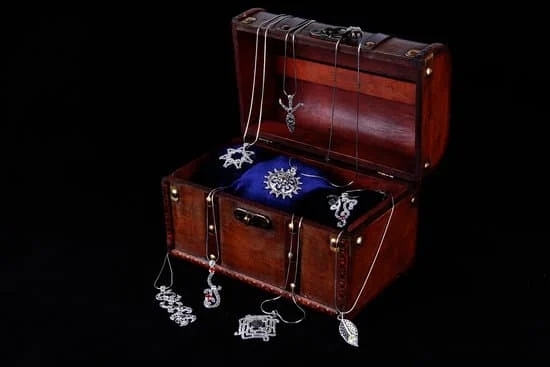Have you ever wondered, is all jewelry handmade? Handmade jewelry has a rich history dating back centuries, with artisans creating unique and personalized pieces using traditional techniques. In this article, we will explore the world of handmade jewelry and its significance in today’s market.
Handmade jewelry holds a special place in the hearts of many individuals, as it represents more than just an accessory. It embodies craftsmanship, creativity, and artistry, making each piece one-of-a-kind. Throughout history, handmade jewelry has been treasured for its beauty and personal touch, serving as a form of self-expression and cultural representation.
As we delve into the different definitions of handmade jewelry and uncover common misconceptions and myths surrounding it, we will also discuss the rise of machine-made jewelry and its impact on the handmade industry. Despite this challenge, supporting independent artisans and craftsmen remains crucial in preserving the artistry and authenticity of handmade jewelry. Join us on this journey as we celebrate the beauty and significance of handmade jewelry.
What Constitutes Handmade Jewelry
The definition of handmade jewelry varies depending on the perspective and criteria used. In general, handmade jewelry refers to pieces that are crafted by hand, without the use of mass-produced machinery. However, this definition can be broadened to include a range of techniques and processes.
Some artisans may use traditional tools such as hammers and anvils to forge metal, while others may focus on intricate wire-wrapping or beading techniques. Ultimately, the key factor is that each piece is individually crafted with care and attention to detail.
One common misconception is that all handmade jewelry is created entirely from scratch, with artisans mining their own materials and refining them from raw form. While this may be true for some independent jewelers, many artisans source their materials from reputable suppliers. This allows them to focus on the design and fabrication aspects of their work while ensuring the quality and authenticity of the materials they use.
Another consideration when defining handmade jewelry is whether the piece undergoes any form of mechanized production. Some artisans may incorporate limited machine processes into their work, such as using a rolling mill to flatten metal or a kiln for firing enamel. While these tools can enhance efficiency and consistency, they are often used in conjunction with extensive handcrafted techniques.
To dive deeper into what constitutes handmade jewelry, it’s essential to consider the level of artisan involvement in each stage of production. This includes designing, shaping, assembling, finishing, and any additional embellishments or personalization. By understanding the various definitions and factors that contribute to handmade jewelry, consumers can make informed choices when seeking authentic artisan-crafted pieces.
| Handmade Jewelry Definition | Description |
|---|---|
| Crafted by Hand | Jewelry made without mass-produced machinery |
| Materials Sourcing | Artisans may source materials from reputable suppliers |
| Artisan Involvement | Consideration of level of involvement in each stage of production |
The Advantages of Handmade Jewelry
When it comes to jewelry, there is a certain charm and allure that comes with handmade pieces. Whether it’s a delicate necklace, a bold statement ring, or a pair of elegant earrings, the craftsmanship and attention to detail that goes into handmade jewelry is unparalleled. The process of creating handmade jewelry involves a level of care and artistry that simply cannot be replicated by mass-produced pieces.
The advantages of handmade jewelry are numerous, making them highly coveted by those who appreciate quality, unique designs, and a personal touch. Here are some key reasons why handmade jewelry stands out in the world of accessories:
- Quality: Handmade jewelry is crafted with meticulous attention to detail and using high-quality materials. Each piece is carefully inspected and assembled by skilled artisans, ensuring that it meets exacting standards of craftsmanship.
- Unique Designs: One of the most appealing aspects of handmade jewelry is its individuality. Unlike mass-produced items that are often replicated in large quantities, handmade pieces offer distinct designs that are truly one-of-a-kind. Artisans infuse their creativity and personal style into each piece they create, resulting in jewelry that is as unique as the wearer.
- Personal Touch: Handmade jewelry carries an emotional connection between the maker and the wearer. Whether it’s a custom-made piece or a limited edition creation, there is an intimate story behind every handmade jewel. This personal touch adds depth and meaning to the jewelry, creating a special bond between the artisan and the consumer.
Ultimately, choosing handmade jewelry not only allows you to own a beautifully crafted accessory but also supports independent artists and craftsmen. The next time you’re in search of a new piece to add to your collection or looking for a meaningful gift for someone special, consider the allure of handmade jewelry – where quality meets artistry.
Misconceptions About Handmade Jewelry
There is a common misconception that all jewelry handmade. People often assume that if a piece of jewelry is not machine-made, it must be handmade. However, this is not always the case. Many jewelry pieces labeled as “handmade” may actually involve some level of machinery in their production process. It’s important to understand the difference between truly handcrafted jewelry and items that are simply assembled by hand using prefabricated components.
Another misconception about handmade jewelry is that it is less durable and of lower quality compared to machine-made pieces. In reality, many artisans who create handmade jewelry take great pride in their craftsmanship and pay attention to detail, resulting in high-quality, long-lasting pieces. Additionally, handmade jewelry often features unique designs and materials that are not commonly found in mass-produced items.
Some people also believe that handmade jewelry is too expensive and not worth the investment. While it’s true that handcrafted pieces can come with a higher price tag due to the time and skill involved in their creation, they offer a level of uniqueness and personal touch that cannot be matched by mass-produced jewelry. When you purchase a handmade piece, you are not only buying a beautiful accessory but also supporting the work of independent artisans and craftsmen.
In today’s market, there is a growing demand for authentic handmade jewelry as consumers seek out one-of-a-kind pieces with a story behind them. The rise of machine-made jewelry has made the appreciation for genuine handcrafted items even more significant as they offer individuality, quality, and artistry that cannot be replicated on an assembly line.
| Misconception | Truth |
|---|---|
| All jewelry labeled as “handmade” is truly created by hand | Many “handmade” pieces involve some level of machinery in their production processes |
| Handmade jewelry is less durable and lower quality compared to machine-made pieces | Many artisans take great pride in their craftsmanship, resulting in high-quality, long-lasting pieces |
| Handmade jewelry is too expensive an investment | While prices may be higher due to the time involved, they offer uniqueness and support for independent artisans |
| The rise of machine-made jewelry diminishes the appreciation for authentic handmade items | The demand for genuine handcrafted items continues to grow due to their unique qualities and artistry. |
How to Identify Handmade Jewelry
When it comes to purchasing jewelry, many people prefer handmade pieces for their unique designs and personal touch. However, with the rise of machine-made jewelry, it can be challenging to identify authentic handcrafted pieces. Here are some tips for spotting handmade jewelry:
- Examine the craftsmanship: Handmade jewelry often exhibits a high level of attention to detail and precision in its construction. Look for evidence of hand tool marks or slight variations that are characteristic of artisanal work.
- Inspect the materials: Artisans frequently use unique and high-quality materials in their creations. Check for natural gemstones, hand-forged metals, and other distinctive components that showcase the individuality of the piece.
- Seek out artisan signatures: Many independent jewelry makers sign their work as a way to authenticate their creations. Look for initials, logos, or stamps that indicate the piece was crafted by a specific artist.
It is essential to note that just because a piece is labeled as “handmade” does not necessarily mean it meets these criteria. Some mass-produced items may be falsely marketed as handmade to command higher prices. Therefore, it’s crucial to educate yourself on how to differentiate between authentic handmade jewelry and manufactured replicas.
Ultimately, by honing your ability to identify genuine handcrafted pieces, you can ensure that your jewelry collection reflects the artistry and creativity of independent artisans. Patronizing these skilled craftsmen not only supports their livelihood but also allows you to own unique, one-of-a-kind treasures that tell a story and carry a personal connection.
The Rise of Machine-Made Jewelry
As technology continues to advance, the jewelry industry has also seen a rise in machine-made jewelry. This shift from traditional handmade methods to mass production has had a significant impact on the handmade jewelry industry. Understanding the implications of this change is crucial for both consumers and artisans alike.
Impact on Artisans
The rise of machine-made jewelry has posed several challenges for independent artisans. With the convenience and cost-effectiveness of machine production, many consumers are drawn to mass-produced pieces, leaving handmade artisans struggling to compete in the market. This has led to a decline in opportunities for craftsmen and women who rely on their skills to make a living.
Quality and Authenticity
One of the major concerns with machine-made jewelry is the compromise on quality and authenticity. Mass-produced pieces often lack the attention to detail and craftsmanship that is synonymous with handmade jewelry. As a result, consumers may find themselves purchasing items that are not as durable or unique as those created by skilled artisans.
Environmental Impact
The increase in machine-made jewelry also raises concerns about its environmental impact. Mass production often involves industrial processes that contribute to pollution and waste. On the other hand, handmade jewelry typically uses sustainable practices and materials, making it a more environmentally-friendly choice.
Understanding the impact of machine-made jewelry on the handmade industry is essential for both consumers and artisans. It highlights the importance of supporting independent craftsmen and women who pour their creativity and expertise into each piece they create.
Supporting Handmade
Preserving Artistic Traditions
One of the most compelling reasons to support handmade jewelry is the preservation of artistic traditions. Many independent artisans and craftsmen utilize age-old techniques that have been passed down through generations, creating pieces that carry with them a sense of history and cultural significance. By patronizing these artists, consumers not only acquire unique and meaningful jewelry but also contribute to the continuation of traditional craftsmanship.
Encouraging Creativity and Innovation
Independent artisans are often driven by a passion for creativity and innovation. Unlike mass-produced jewelry, handmade pieces are born from the imagination and skill of individual artisans, resulting in designs that are truly one-of-a-kind. By supporting these craftsmen, consumers foster an environment where artistic expression thrives, leading to a diverse range of styles and techniques within the jewelry industry.
Fostering Economic Sustainability
Another important aspect of supporting independent artisans and craftsmen is the promotion of economic sustainability. When consumers choose to purchase handmade jewelry, they directly contribute to the livelihoods of individual artists and small-scale businesses. This direct support helps sustain local economies, empowering artists to continue their craft while fostering a greater sense of community within the industry.
Conclusion
In conclusion, it is clear that handmade jewelry holds a special place in the hearts of many individuals. The artistry and craftsmanship that goes into creating these pieces make them truly unique and valuable. While there may be misconceptions and myths surrounding handmade jewelry, the truth is that these pieces are a labor of love, often showcasing the skills and creativity of talented artisans.
Furthermore, the advantages of handmade jewelry cannot be overstated. From the high-quality materials used to the personalized touch that each piece embodies, there is something truly special about owning a handmade item. Whether it’s a necklace, bracelet, or pair of earrings, handmade jewelry offers a level of attention to detail that is unmatched by mass-produced items.
As we continue to navigate through the rise of machine-made jewelry, it is important to support independent artisans and craftsmen who pour their passion into creating beautiful pieces. By patronizing these individuals and investing in their work, we not only embrace the beauty of handmade jewelry but also contribute to preserving this timeless art form for generations to come.
So, let’s celebrate and cherish the artistry found in handmade jewelry and continue to recognize its significance in today’s society.
Frequently Asked Questions
How Can You Tell if Jewelry Is Handmade?
Jewelry that is handmade often exhibits unique and individualized characteristics such as slight variations in size, shape, and design. Additionally, the presence of imperfections or irregularities can be a sign that the piece was crafted by hand.
What Is the Difference Between Cast and Handmade Jewelry?
The main difference between cast and handmade jewelry lies in the production process. Cast jewelry is created using molds and mass production techniques, resulting in identical pieces, while handmade jewelry is individually crafted without the use of molds, making each piece unique.
What Is the Difference Between Handcrafted and Handmade Jewelry?
While both terms are often used interchangeably, there is a subtle difference between handcrafted and handmade jewelry. Handmade jewelry implies that the piece was made entirely by hand without the use of machinery, while handcrafted jewelry may involve some level of machine assistance in the creation process but still requires significant manual skills from the artisan.

Welcome to my jewelry blog! My name is Sarah and I am the owner of this blog.
I love making jewelry and sharing my creations with others.
So whether you’re someone who loves wearing jewelry yourself or simply enjoys learning about it, be sure to check out my blog for insightful posts on everything related to this exciting topic!





